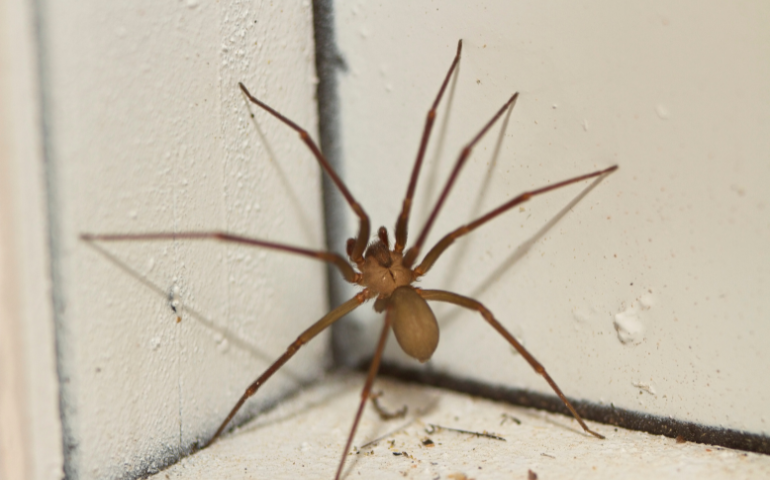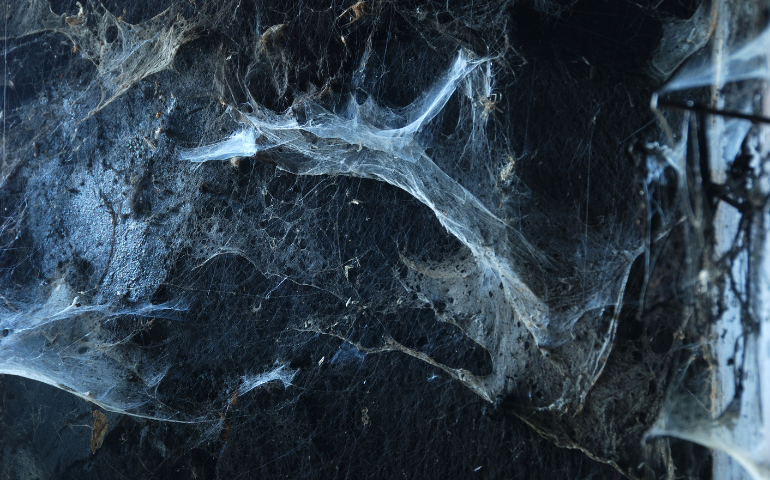Brown recluse spiders are one of the most reclusive household pests—literally. They prefer to stay hidden, which is why most people don’t realize they have an issue until it starts to grow. If you’ve seen a suspicious spider or are waking up with unexplained bites, you might be wondering if it’s more than just a one-time visitor.
Let’s take a look at what a brown recluse infestation really looks like and what you can do about it.
What Counts as a Brown Recluse Infestation?

Seeing one brown recluse spider doesn’t always mean you have an infestation. But if you’re finding them regularly in different areas of your home—or discovering egg sacs, webs, or bites—you could be dealing with something more serious.
Brown recluse infestations typically occur in quiet, undisturbed places like attics, crawl spaces, closets, and garages. They prefer cluttered environments and dark corners, especially where cardboard boxes or stored belongings are left untouched. An infestation usually means there are multiple spiders living and reproducing indoors, and without treatment, the problem will only get worse over time.
Signs You Have a Brown Recluse Infestation
Here are the most common signs that brown recluse spiders might be hiding out in your home:
1. Multiple Brown Spider Sightings Indoors
Spotting more than one brown spider—especially in low-traffic areas like under beds, behind furniture, or in closets—is a major sign. Brown recluse spiders are light to dark brown, around ¼ to ½ an inch long, and have a violin-shaped mark on their back. Unlike most spiders, they have only six eyes arranged in pairs.
If you’re noticing them in different rooms or repeatedly over time, it’s more than just coincidence.
2. Bites That Happen Overnight
Brown recluse bites usually happen when the spider feels trapped—like when someone rolls over on it while sleeping or puts on clothing or shoes it’s hiding in. These bites can start off looking like a small red bump and then develop into blisters or ulcers. While most bites heal on their own, some can become painful and require medical attention.
If you or a family member is waking up with strange bites that keep coming back, it could be a sign of hidden spiders in your home.
3. Irregular Webs in Low-Traffic Areas

Brown recluse webs aren’t the typical round ones you might see in corners. They’re messy, loose, and often tucked away in places like behind furniture, inside cardboard boxes, or along basement walls. These webs are mostly used for hiding rather than catching prey.
4. Egg Sacs or Baby Spiders
Female brown recluses lay small white egg sacs, each holding up to 50 spiderlings. If you find these sacs—or tiny brown spiders clustered together—it’s a clear sign that spiders are reproducing indoors. You’re most likely to find them in dark corners, storage bins, or behind wall hangings.
5. More Activity During Warmer Months
Brown recluse spiders tend to be more active in spring and summer, especially between April and October. If spider sightings suddenly increase during these months, they might be on the move looking for food or a mate.
How Brown Recluse Spiders Get Into Homes
Most infestations begin with just one or two spiders that find their way indoors. They can enter through small cracks in the foundation, gaps around doors and windows, or attic vents. Many are unknowingly brought inside in boxes, secondhand furniture, or firewood.
Once inside, they’ll settle into undisturbed areas—especially if there are dark, dry hiding spots and easy access to food.
What Brown Recluse Spiders Eat
Brown recluse spiders feed on small insects like cockroaches, ants, and silverfish. If you already have other pests in your home, they’re more likely to stick around. In some cases, seeing brown recluses may be a sign of a larger pest problem.
By eliminating other bugs, you can make your home less attractive to these spiders.
Are Brown Recluses Dangerous?
Brown recluse bites are not as common as people think, but they can be serious. Most bites are mild and heal on their own, but some can result in skin damage, infection, or prolonged healing. The danger increases for children, elderly individuals, or people with compromised immune systems.
If you suspect a bite and the area becomes painful, swollen, or starts to blister, it’s best to seek medical care right away.
DIY Spider Control vs. Professional Help
While there are plenty of DIY spider sprays and traps out there, they rarely address the root of the problem. Brown recluses are experts at hiding in wall voids, behind insulation, or under floorboards—places that over-the-counter treatments usually can’t reach.
Professional pest control offers a better long-term solution. We can target the areas you can’t see and help prevent spiders from coming back.
How Alta Pest Control Gets Rid of Brown Recluse Spiders

We use a proven process that targets brown recluse spiders where they live, without disrupting your home. Our quarterly pest control services include spraying around the foundation and baseboards, de-webbing eaves and low-traffic areas, yard granulation to cut off the spider’s food source, and placing traps or monitors in key hiding spots.
We also offer other services like rodent exclusion, attic insulation, and termite control for extra protection.
Why Choose Alta Pest Control?
We’re a family-owned company with thousands of five-star reviews and a team that cares deeply about your experience. Our technicians are knowledgeable, honest, and friendly, and we’ll always communicate clearly about what we’re doing and why.
Our spider control treatments are friendly for kids, pets, and plants. We offer flexible long-term service plans with a satisfaction guarantee that includes free re-treatments between visits if needed.
Schedule Brown Recluse Spider Control Today
If you’re seeing signs of a brown recluse infestation, we’re here to help. Contact Alta Pest Control today at 866-201-7787 to schedule your first treatment. We’ll eliminate the problem—and give you one less thing to worry about.
FAQs
How do you know if you have an infestation of brown recluse spiders?
If you’re seeing multiple brown spiders indoors, finding egg sacs, spotting irregular webs in quiet areas, or waking up with unexplained bites, you may be dealing with a brown recluse infestation. These spiders tend to hide in undisturbed places like closets, attics, and storage boxes, so consistent sightings are a red flag.
How do you stop a brown recluse infestation?
The most effective way to stop a brown recluse infestation is through professional pest control. At Alta, we treat the areas where spiders hide, remove webs, reduce their food sources, and set up a long-term plan to prevent them from coming back. DIY methods usually don’t reach the hidden areas where they live and reproduce.
What months are brown recluse spiders most active?
Brown recluse spiders are most active from spring through early fall—especially between April and October. Warmer weather causes them to move more often in search of food or mates, which is when infestations become more noticeable.
Where do brown recluse nest?
Brown recluse spiders don’t build traditional nests like some insects. Instead, they hide in dark, quiet spaces like attics, basements, storage closets, inside cardboard boxes, under furniture, or behind wall hangings. They lay egg sacs in these undisturbed areas, which can lead to an infestation over time.
Share article:
